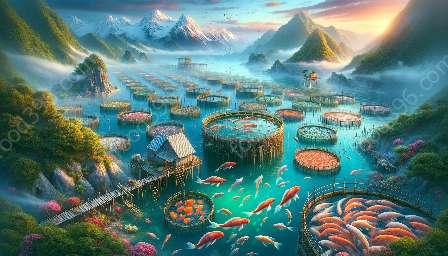Aquaculture of seafood species has become increasingly important due to the growing demand for seafood and the diminishing availability of wild-caught fish. This has led to a need for a comprehensive economic analysis of aquaculture operations for seafood species, which encompasses the financial aspects of production, market trends, and profitability.
Understanding the Economics of Aquaculture
Aquaculture, also known as fish farming, involves the cultivation of aquatic organisms under controlled conditions. When it comes to seafood species, such as fish, shellfish, and crustaceans, economic analysis plays a crucial role in determining the viability and sustainability of aquaculture operations.
The economic analysis of aquaculture operations for seafood species involves assessing various cost factors, including investment in infrastructure, labor, feed, water quality management, disease control, and transportation. Furthermore, the analysis takes into account revenue streams, such as the sale of harvested seafood, value-added products, and potential export opportunities.
Economic Impacts on Seafood Production
Seafood science, which encompasses the study of aquatic organisms and their cultivation, intersects with the economic analysis of aquaculture operations. The production of seafood species requires a deep understanding of biological, environmental, and economic factors to ensure sustainable and profitable operations.
Market trends, consumer demand, and environmental regulations all have substantial effects on the economics of aquaculture operations. Seafood science provides valuable insights into the biological and environmental aspects of producing seafood species, which directly influence the economic feasibility of aquaculture.
Factors Influencing Profitability
The profitability of aquaculture operations for seafood species is influenced by various factors, including the species being cultivated, production scale, geographic location, technological advancements, and market conditions. For example, high-value seafood species, such as shrimp and salmon, may yield higher profits but also involve greater investment and operational risks.
Additionally, the application of innovative techniques, such as recirculating aquaculture systems (RAS) and integrated multi-trophic aquaculture (IMTA), can impact the economic efficiency and environmental sustainability of seafood production.
Challenges and Opportunities
Understanding the economic analysis of aquaculture operations for seafood species also involves recognizing the challenges and opportunities within the industry. These may include market competition, fluctuating commodity prices, environmental sustainability, regulatory compliance, and technological advancements.
Despite the challenges, aquaculture of seafood species presents significant opportunities for meeting the growing global demand for high-quality protein sources. The economic analysis of aquaculture operations can identify areas for innovation, cost efficiency, and market diversification to capitalize on the opportunities within the seafood industry.
The Future of Aquaculture Economics and Seafood Science
The future of aquaculture economics and seafood science is set to be driven by advancements in sustainable aquaculture practices, technological innovations, and market diversification. As the demand for seafood continues to rise, the integration of economic analysis with seafood science will play a crucial role in shaping the future of aquaculture operations for seafood species.
By embracing a holistic approach that considers the financial, biological, and environmental aspects of aquaculture, the industry can optimize production efficiency, minimize environmental impacts, and meet the evolving market demands for seafood products.

